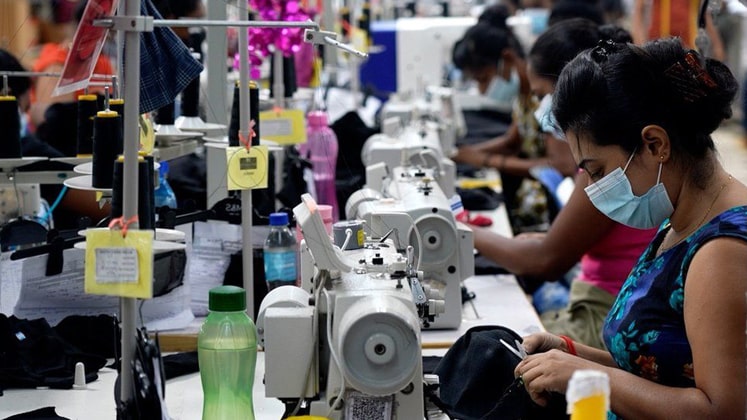Sri Lanka kicked off 2022 with an overwhelming apparel export figures of US $ 487.60 million in January, noting an impressive 23 per cent growth over January ’21, which was the highest in last six years (at least), surpassing the previous best figure of US $ 452 million (in January ’19). Subsequently, in February ’22, the apparel exports reached US $ 468.12 million, growing by around 11.54 per cent on year-on-year (Y-o-Y) basis.
However, it didn’t take much time for the scenario to change – and change for the worst. The country’s foreign exchange reserves slumped by 70 per cent to US $ 2.30 billion as of February ’22 in the past two years, thereby impacting the country’s ability to import food and fuel – eventually leading to power cuts and skyrocketing prices.
With no electricity for 12 hours a day, the country has been going through a major energy crisis – not to mention the hardships faced by the industries owing to shortage of fuel. Also, with food prices going very high, Sri Lanka is presently battling one of its worst economic crises.
Notably, the worst affected is the country’s apparel sector – whose export contributes 6 per cent to the country’s GDP and accounts for 40 per cent of all exports that provides direct employment to 350,000 workers, with additional 700,000 receiving livelihood opportunities as part of the well-built supply chain.
Overall, the sector today has about 300 factories that generated export revenues of US $ 5.40 billion in 2021. So, over 1.10 million people (directly) are affected by the prevailing situation in the country in just apparel sector alone! That’s agonising by all standards!
The rising cost of shipping and logistics has been a growth impediment factor in the apparel industry despite the fact that Sri Lanka has shown robust growth in its exports but the current crisis seems to be hurting the business the most. The Joint Apparel Association Forum (JAAF) – the apex body of Sri Lanka’s apparel industry – has raised concerns over the apparel industry’s ability to continue its operations due to the prevailing fuel and power crisis.
Corroborating further, Yohan Lawrence, Secretary General, JAAF, said“The fuel shortage is having a massive impact on our day-to-day production. We are unable to use our generators during power outages because of the lack of diesel. To add to this, fuel shortages are affecting our ability to transport our goods and provide staff transport for our employees.”
Notably, the apparel factories running here may not see any immediate major impact, but as the situation gets more intense day by day, the impact may be seen for sure in coming days.
Even the Bank of Investment (BOI)-run Export Processing Zones too have been experiencing prolonged power cuts. It’s pertinent to mention here that, in Sri Lanka, around 80 per cent of SMEs work in partnership with larger players and they are the ones most impacted by the power cuts.
However, bigger manufacturers are still managing somehow owing majorly to their multi-national manufacturing operations – not to mention the abundance of human and economic resources that they have. In a response sent to Apparel Resources, Adam Collins, General Manager, Corporate Affairs & Investor Relations, Hela Clothing (Sri Lanka) stated on similar lines, “The current situation in Sri Lanka is very challenging, but it was also not sudden and we have been monitoring the risk of an economic crisis for some time as part of our wider enterprise risk management strategy. As an export-oriented company with 100 per cent USD-denominated revenue, we are less affected than other local industries and our operations have been continuing as normal so far. Nonetheless, our teams are also proactively working with the authorities to ensure that we have sufficient resources to continue our manufacturing operations without interruption.”
Adam further informed Team AR that the company provides transport to and from its manufacturing locations for all employees who require it and, as such, the organisation has not been affected by any disruptions to public transport.
The story, unfortunately, isn’t same for small manufacturers! While incessant power cuts and increasing shortage of diesel seem to have hit their functioning of work more, other forms of disruptions too have been causing bottlenecks – and understandably so. Amidst anti-Government protests across the country, workers struggle to reach their factories because of lack of transportation, which has consequently impacted the smaller players more than the bigger ones. Lack of workers amidst uncertainty and chaos has significantly hit the production in last one month.
Reporting the same, Broadway Kids apparel factory in Sri Lanka – which employs nearly 300 workers and produces garments for British brands including Next, Matalan, Frugi and John Lewis & Partners – desperately looks to get 200 litres of diesel everyday so it can run its generators during power cuts and keep working. “Once we get the fuel, we have to guard the cans because they might be stolen. That is how desperate people are for fuel,” comments the factory’s associate as per Reuters’ report.
In most of the apparel factories, the management is now forced to spend 400 per cent more on fuel and generator costs, compared to the same period last year, which has pushed up overheads. With fewer operating hours, workers are likely to get paid one-third less this month as they don’t work over-time.
Impact on buyer’s trust!
When a country faces such overwhelming economic crisis, especially due to political failure, there is certain distrust amongst buying fraternity for that country. The same is feared by Sri Lankan apparel industry, which has always believed to maintain a high level of confidence amongst apparel buyers across the globe. “If our buyers start losing confidence in us and move to other competing markets, getting them back will be extremely challenging,” Lawrence substantiates.
“We operate on very thin margins,” commented Chula Dharmadasa, Owner, Broadway Kids, adding, “I’m already getting warnings from clients that if we miss delivery targets, we have to air freight goods, which we cannot afford to do. Our orders will get cancelled and buyers will move to competitors like Bangladesh.” Losses of one company can impact the entire value chain and potentially lead to job losses, feels Chula.
When reached out by Apparel Resources to get a response on the prevailing crisis, JAAF responded, “At this point, our orders are secure for the next 3 to 4 months. However, the frequent power outages are making it difficult to fulfil these orders on time, particularly before Sri Lanka’s New Year holidays in April. Some manufacturers are resorting to delivering their goods using air freight, which is very costly.”
Adam Collins of Hela responded that the companyfocuses on building long-term strategic relationships with its customers, rather than purely transactional engagements, and as a result, the buyers have been overwhelmingly supportive during this period and open to exploring ways that they can help.
“Political and economic instability is also not unusual in key apparel sourcing hubs, so our customers also appreciate the nuances. This is also one reason why we have a diversified manufacturing footprint across multiple countries, as it allows us to flex our capacity elsewhere if the event production is disrupted due to a country-specific reason,” averred Adam.
Hope still persists!
The apparel industry of Sri Lanka is still unsure on how to resolve the crises, but all is not lost. Yes, India has been at the forefront in helping the Island nation by sending a consignment of 40,000 metric tonnes of diesel – the fourth such assistance from New Delhi – to mitigate the spike in power cuts. But despite India’s move to extend a US $ 1 billion line of credit (LoC) – following a previous US $ 500 million LoC in February – what Sri Lanka desperately needs today is a well-etched out strategy to have a robust internal system that can help it fight the economic crisis, bring stability and enable the industry and the country regain the good old days of glory.
This is not the first time Sri Lanka is going through a tough time and this is not the first time the apparel industry of the country is facing challenges and constraints. There’s hope for revival! And no one has put it better than MAS Holdings, which says “The apparel industry has always been a pillar of strength to Sri Lanka’s economy through many difficult periods of its history, and we will continue to support a long-term, equitable and sustainable recovery plan. We are confident that as a nation we will emerge stronger through this challenging time and prove our resilience once again.”
They have done it before and they can do it again!







